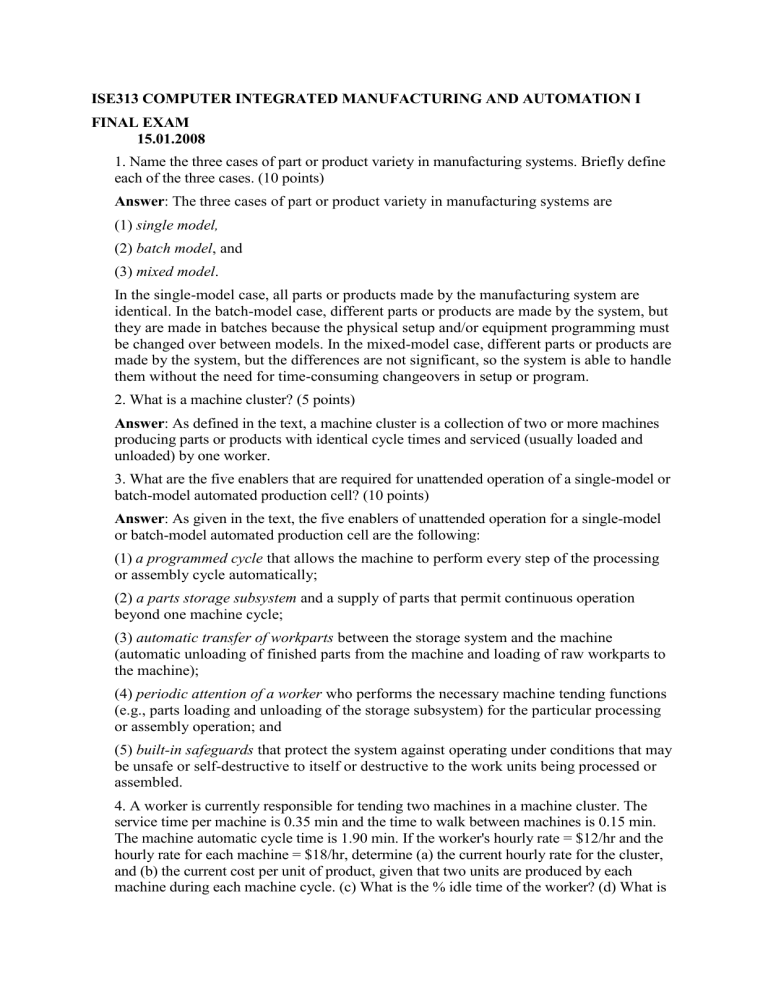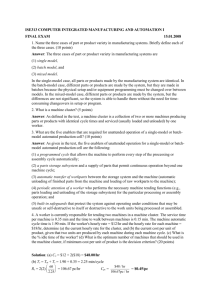
ISE313 COMPUTER INTEGRATED MANUFACTURING AND AUTOMATION I
FINAL EXAM
15.01.2008
1. Name the three cases of part or product variety in manufacturing systems. Briefly define
each of the three cases. (10 points)
Answer: The three cases of part or product variety in manufacturing systems are
(1) single model,
(2) batch model, and
(3) mixed model.
In the single-model case, all parts or products made by the manufacturing system are
identical. In the batch-model case, different parts or products are made by the system, but
they are made in batches because the physical setup and/or equipment programming must
be changed over between models. In the mixed-model case, different parts or products are
made by the system, but the differences are not significant, so the system is able to handle
them without the need for time-consuming changeovers in setup or program.
2. What is a machine cluster? (5 points)
Answer: As defined in the text, a machine cluster is a collection of two or more machines
producing parts or products with identical cycle times and serviced (usually loaded and
unloaded) by one worker.
3. What are the five enablers that are required for unattended operation of a single-model or
batch-model automated production cell? (10 points)
Answer: As given in the text, the five enablers of unattended operation for a single-model
or batch-model automated production cell are the following:
(1) a programmed cycle that allows the machine to perform every step of the processing
or assembly cycle automatically;
(2) a parts storage subsystem and a supply of parts that permit continuous operation
beyond one machine cycle;
(3) automatic transfer of workparts between the storage system and the machine
(automatic unloading of finished parts from the machine and loading of raw workparts to
the machine);
(4) periodic attention of a worker who performs the necessary machine tending functions
(e.g., parts loading and unloading of the storage subsystem) for the particular processing
or assembly operation; and
(5) built-in safeguards that protect the system against operating under conditions that may
be unsafe or self-destructive to itself or destructive to the work units being processed or
assembled.
4. A worker is currently responsible for tending two machines in a machine cluster. The
service time per machine is 0.35 min and the time to walk between machines is 0.15 min.
The machine automatic cycle time is 1.90 min. If the worker's hourly rate = $12/hr and the
hourly rate for each machine = $18/hr, determine (a) the current hourly rate for the cluster,
and (b) the current cost per unit of product, given that two units are produced by each
machine during each machine cycle. (c) What is the % idle time of the worker? (d) What is
the optimum number of machines that should be used in the machine cluster, if minimum
cost per unit of product is the decision criterion? (20 points)
Solution: (a) Co = $12 + 2($18) = $48.00/hr
(b) Tc = Tm + Ts = 1.90 + 0.35 = 2.25 min/cycle
Rc = 2(2)
60
= 106.67 pc/hr
2.25
Cpc =
$48 / hr
106.67pc / hr
= $0.45/pc
(c) Worker engagement time/cycle = 2(Ts + Tr) = 2(0.35 + 0.15) = 1.0 min
Idle time IT =
(d) n =
2.25 1.0
= 0.555 = 55.5%
2.25
1.90 0.35
= 2.25/0.5 = 4.5 machines
0.35 0.15
n1 = 4 machines: Cpc(4) = 0.5(12/4 + 18(2.25/60) = $0.394/pc
n2 = 5 machines: Cpc(5) = 0.5(12 + 18x5)(0.50/60) = $0.425/pc
Use n1 = 4 machines
5. Name four of the six measures used to assess the performance of a storage system? (10
points)
Answer: The six performance measures discussed in the text are the following:
(1) storage capacity, which is defined and measured either as the total volumetric space
available or as the total number of storage compartments in the system available for items
or loads;
(2) storage density, defined as the volumetric space available for actual storage relative to
the total volumetric space in the storage facility;
(3) accessibility, which refers to the capability to access any desired item or load stored in
the system;
(4) system throughput, defined as the hourly rate at which the storage system receives and
puts loads into storage and/or retrieves and delivers loads to the output station;
(5) utilization, which is defined as the proportion of time that the system is actually being
used for performing storage and retrieval operations compared with the time it is
available, and
(6) availability, defined as the proportion of time that the system is capable of operating
(not broken down) compared with the normally scheduled shift hours.
6. An AS/RS with four aisles is 80 m long and 18 m high. The S/R machine has a maximum
speed of 1.6 m/s in the horizontal direction. It accelerates from zero to 1.6 m/s in a distance
of 2.0 m. On approaching its target position (where the S/R machine will transfer a load
onto or off of its platform), it decelerates from 1.6 m/s to a full stop in 2.0 m. The maximum
vertical speed is 0.5 m/s, and the acceleration and deceleration distances are each 0.3 m.
Rates of acceleration and deceleration are constant in both directions. Pick and deposit time
= 12 s. Utilization of the AS/RS is assumed to be 90%, and the number of dual command
cycles = the number of single command cycles. (a) Calculate the single command and dual
command cycle times, including considerations for acceleration and deceleration. (b)
Determine the throughput rate for the system. (25 points)
t
Solution: (a) Horizontal travel: v = adt = at = 1.6 m/s, a = 1.6/t
0
t
y = atdt = at2/2 = 0.5(1.6/t) t2 = 0.8 t = 2 m
t = 2/0.8 = 2.5 s.
0
t
Vertical travel: v = adt = at = 0.5 m/s, a = 0.5/t
0
t
z = atdt = at2/2 = 0.5(0.5/t) t2 = 0.25 t = 0.3 m
t = 0.3/0.25 = 1.2 s.
0
Tcs = 2 Max
0.5(80) 2(2)
0.5(18) 2(0.3)
2(2.5),
2(12
. ) + 2(12) = 79 s/cycle = 1.3167
16
.
0.5
min/cycle
Tcd = 2 Max
0.75(80) 3(2)
0.75(18) 3(0.3)
3(2.5),
3(12
. ) + 4(12) = 130.5 s/cycle = 2.175
16
.
0.5
min/cycle
(b) Rcs Tcs + Rcd Tcd = 60(0.90) = 54 min
Given Rcs = Rcd, 1.3167 Rcs + 2.175 Rcs = 3.4917 Rcs = 54.0
Rcs = 15.465
cycles/hr
Rcd = Rcs = 15.465 cycles/hr
Rt = Rcs + 2 Rcd = 15.465 + 2(15.465) = 46.396 transactions/hr per aisle
With 4 aisles, Rt = 4(46.396) = 185.6 transactions/hr
7. A recirculating conveyor has a total length of 700 ft and a speed of 90 ft/min. Spacing of
part carriers = 14 ft. Each carrier can hold one part. Automatic machines load and unload
the conveyor at the load and unload stations. Time to load a part is 0.10 min and unload
time is the same. To satisfy production requirements, the loading and unloading rates are
each 2.0 parts per min. Evaluate the conveyor system design with respect to the (i) speed
rule, (ii) capacity constraint, and (iii) uniformity principle. (20 points)
Solution: (1) Speed rule: Lower limit:
n p vc
sc
Max{RL, Ru}
(1part / carrier )( 90ft / min)
= 6.428 parts/min Max{2, 2} (OK)
14ft / carrier
v
1 1
Upper limit: c Min{ , }
sc
TL Tu
90ft / min.
1 1
= 6.428 carrier/min Min{ , } = Min{10, 10} (OK)
14ft / carrier
01
. 01
.
(2) Capacity constraint: In this case, the flow rate is interpreted to be the specified load and
unload rates,
that is, Rf = RL = Ru = 2 parts/min
n p vc
sc
= 6.428 parts/min 2 (OK)
(3) Uniformity principle: The conveyor is assumed to be uniformly loaded throughout its
length since
RL = Ru and the flow rate capacity is significantly greater than RL and Ru. (OK)
Conclusion: The system is feasible.
ERGONOMICS/MANUAL MATERIAL HANDLING
1) Why should we apply Ergonomics to design manual MHS?
Manual handling of containers may expose workers to physical conditions (e.g., force,
awkward postures, and repetitive motions) that can lead to injuries, wasted energy, and
wasted time. To avoid these problems, your organization can directly benefit from improving
the fit between the demands of work tasks and the capabilities of your workers. Remember
that workers’ abilities to perform work tasks may vary because of differences in age, physical
condition, strength, gender, stature, and other factors. In short, changing your workplace by
improving the fit can benefit your workplace by:
Reducing or preventing injuries
Reducing workers’ efforts by decreasing forces in lifting, handling, pushing, and
pulling materials
Reducing risk factors for musculoskeletal disorders (e.g., awkward postures from
reaching into containers)
Increasing productivity, product and service quality, and worker morale
Lowering costs by reducing or eliminating production bottlenecks, error rates or
rejects, use of medical services because of musculoskeletal disorders, workers’
compensation claims, excessive worker turnover, absenteeism, and retraining




